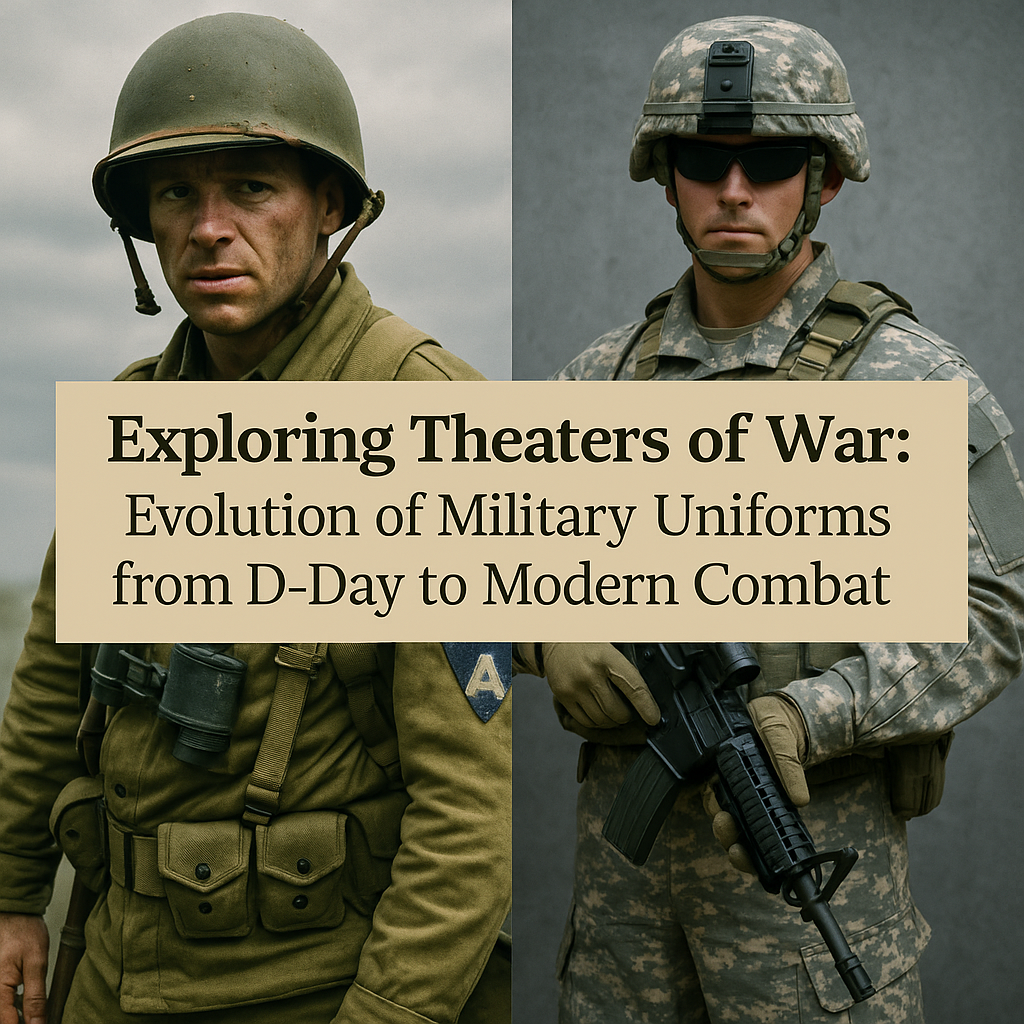
Exploring Theaters of War: Evolution of Military Uniforms from D-Day to Modern Combat
Published on May 11, 2025
Theatres of War: How Combat Zones Shaped Military Uniforms
Throughout history, theatres of war have dictated not only military strategy but also the evolution of the soldier’s gear. One of the most symbolic elements of a military force is its uniform—designed for camouflage, durability, and identity. From the D-Day world war one uniforms worn on the beaches of Normandy to the contemporary universal camouflage pattern uniform used in Iraq and Afghanistan, each piece tells a story of innovation, necessity, and adaptation.
In this article, we’ll explore how global conflict zones shaped the uniforms soldiers wore and how, today, collectors and military enthusiasts can own a piece of that history through used army fatigues and second-hand military clothing.
1. The Historical Significance of Military Uniforms in Theaters of War
Military uniforms serve more than a functional purpose. They symbolize unity, strategy, and evolution. In the early 20th century, uniforms were primarily designed to display rank and allegiance. However, as warfare evolved—especially with the introduction of large-scale and diverse theatres of war—so did the uniform design.
Each theatre, from the European frontlines in WWII to desert warfare in the Middle East, brought unique environmental and tactical challenges. This pushed military designers to rethink materials, colour schemes, and layouts, leading to some of the most iconic military outfits in history.
2. D-Day Uniform: The Birth of Functional Battle Dress
The D-Day invasion of June 6, 1944, was one of the most crucial events in military history. The D-Day uniform, known as the M1943 field uniform, reflected the shift from formality to functionality. These uniforms were crafted for mobility, camouflage, and survival under extreme conditions.
Key Features:
- Olive is a drab colour for camouflage in European terrain
- Reinforced knees and elbows
- Field jackets with multiple pockets
- Durable cotton fabric for comfort and resilience
Today, original or replica D-Day uniforms are prized by collectors and reenactors for their historical accuracy and rugged design. At Paddelaters.com, you can find authentic pieces and inspired second-hand military clothing from this era.
3. Used Army Fatigues: A Legacy That Lives On
Used army fatigues are more than surplus—they are wearable history. These garments have served soldiers in various theatres across the globe and now serve as collectible items, fashion pieces, or gear for tactical training.
Why choose used army fatigues?
- Environmentally sustainable fashion choice
- Built for durability and comfort
- Carries a unique story and character
- Cost-effective compared to new tactical gear
Fatigues used in Vietnam, Korea, and Desert Storm operations are particularly sought after, with their distinctive patterns and tailored design reflecting the needs of each combat zone.
4. Universal Camouflage Pattern Uniform: A Modern Military Milestone
Introduced in the mid-2000s, the Universal Camouflage Pattern (UCP) was designed to be versatile across various terrains—from desert sands to urban environments. It marked a shift toward digital camouflage patterns, attempting to provide a “one-suit-fits-all” solution.
Though later replaced due to limited effectiveness in certain environments, the UCP remains a symbol of post-9/11 military modernization.
Key Characteristics:
- Pixelated gray-green-tan blend
- Moisture-wicking and fire-resistant fabric
- Velcro attachments for name/rank patches
- Integrated with advanced body armour systems
Collectors value the universal camouflage pattern uniform for its cutting-edge design and its unique role in U.S. military history.
5. Current Army Camo: Designed for Today’s Battlefields
Unlike the one-size-fits-all approach of the UCP, today’s military forces use environment-specific camouflage patterns. The current army camo used in the U.S., such as the Operational Camouflage Pattern (OCP), offers enhanced concealment in both woodland and desert terrains.
With modern features like breathable fabrics, modular attachments, and infrared signature reduction, these uniforms are at the cutting edge of tactical gear.
Paddelaters offers a variety of current army camo options, from second-hand military clothing to field-ready tactical gear.
6. Why Collect or Wear Second-Hand Military Clothing?
Military surplus gear isn't just for collectors. There are practical, aesthetic, and ethical reasons people seek out second-hand military clothing and used army fatigues:
- Authenticity: Reenactors and film customers often seek genuine articles for realism.
- Durability: Military clothing is built tougher than most commercial options.
- Style: Vintage army gear has carved a niche in fashion subcultures.
- Sustainability: Buying used reduces demand for new production and keeps items out of landfills.
Whether you're a history buff, hiker, or urban explorer, surplus military gear offers utility and a unique edge.
7. Where to Find Authentic Used Military Uniforms
Paddelaters.com specializes in curating authentic, high-quality military surplus gear. Our inventory includes:
- D-Day uniforms
- Used army fatigues from various eras
- Universal camouflage pattern uniforms
- Current army camo and modern tactical gear
We cater to collectors, cosplayers, survivalists, and everyday adventurers. Each piece is verified for authenticity and condition.
Conclusion: The Uniforms That Tell the Story of War
From the beaches of Normandy to modern-day deployments in the Middle East, the theatres of war have profoundly shaped how soldiers dress, fight, and survive. Military uniforms are more than fabric—they’re a reflection of tactical needs, historical moments, and cultural shifts.
Whether you're collecting D-Day uniforms, seeking used army fatigues, or exploring second-hand military clothing, you're not just buying gear—you’re preserving history.
